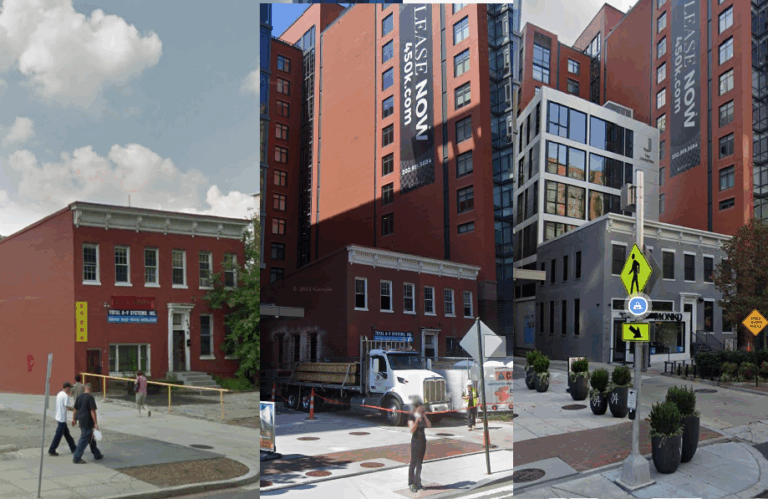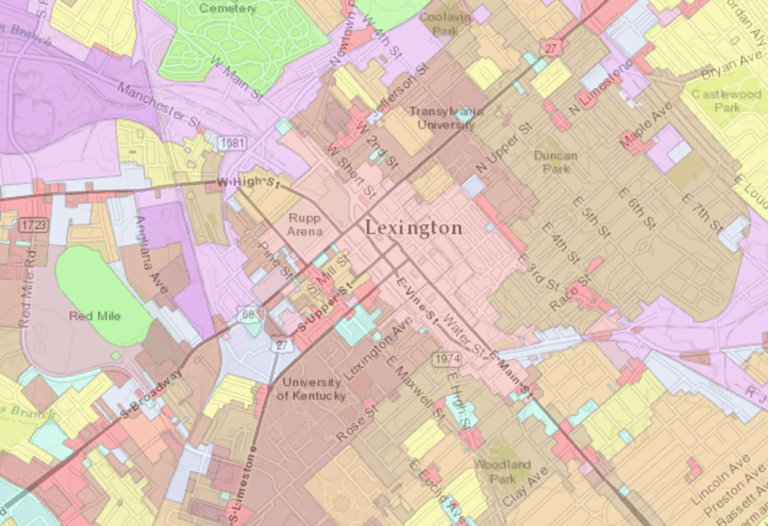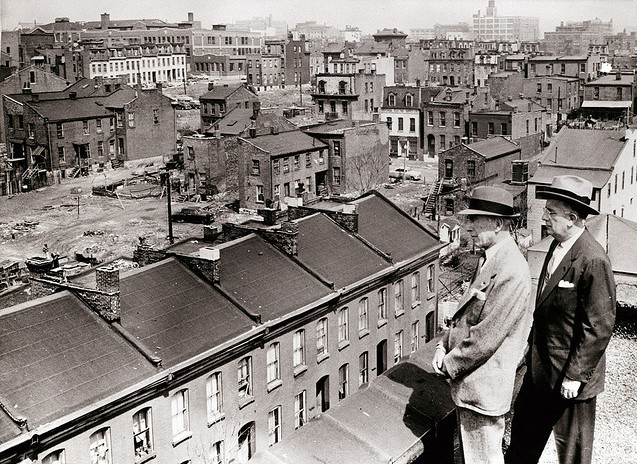Physical Address
304 North Cardinal St.
Dorchester Center, MA 02124
Physical Address
304 North Cardinal St.
Dorchester Center, MA 02124

I walked down the 400 block of K St with an international guest last night. It was hard to describe the transformation of the street. Google Streetview, however, has been there almost since the beginning. 2007 2011 2014 2017 2018…

"These two homes straddle a 2010 zoning boundary change. The result: The house in duplex zoning converted into two homes, and the other converted into a McMansion that cost 80% more." - Arthur Gailes

In many cities, poor people occupy valuable urban land close to downtown jobs, amenities, and transit. They can afford to live there because the housing stock in inner areas is usually older. If it hasn’t been completely renovated, the result can be quite cheap, even if the land is pretty valuable. In areas where there’s already some gentrification pressure, landlords face a timing problem: they can renovate (or sell to a developer) now, and cash out. Or they can hoard the property and wait until prices rise, supplying low-cost housing in the meantime. Land value taxes are specifically designed to penalize the hoard-and-wait approach by raising the annual tax cost of sitting on valuable land. It is specifically designed to accelerate neighborhood change. That’s the point. That’s what it says on the tin. Gentrification isn’t the only urban problem, and maybe it’s a small enough urban problem that a land value tax is a good idea anyway. But I think most of the benefits of Georgism can be unlocked with George-ish schemes (like renovation abatements or vacant land taxes) that are more narrowly designed.

If there’s one thing that unites TV and film since the fifties, it’s the archetype of the dastardly developer – forever destroying homes and hiking rents. But it wasn’t always this way. Where did this trope come from, and is it true? This week on Pop Culture Urbanism, I dig into the cronyism and red tape that turned developers into Hollywood’s favorite villain. Be sure to follow future episodes by subscribing to the Pacific Legal Foundation on YouTube! We have a lot of content in the hopper that you won’t want to miss.

Some commentators are slightly agog over an academic paper by Andres Rodrieguz-Pose and Michael Storper; Richard Florida writes that they shows that ” the effect of [housing] supply has been blown far out of proportion. ” Most of this paper isn’t really about the effect of housing supply on prices at all. Instead, the first 80 percent of the paper seems to argue that it makes no sense for low-skilled domestic workers to live in cities, because “Several decades ago mid-skilled work was clustered in big cities, while low-skilled work was most prevalent in the countryside. No longer; the mid-skilled jobs that remain are more likely to be found in rural areas than in urban ones.” (p. 20). The authors’ attack on upzoning is in the last few pages, and is based on broad, sweeping generalizations rather than actual data. First, they say that upzoning “would very likely involve replacing older and lower-quality housing stock in areas highly favoured by the market, effectively decreasing housing supply for lower income households in desirable areas.” (p. 30). They cite no source or data for this assertion- just pure conjecture. What’s wrong with their claim? First, such gentrification happens without upzoning; for example, in Chicago’s Lincoln Park, gentrification occurred through renovation of existing structures, rather than new, taller buildings- and of course places where new construction is politically difficult (such as San Francisco and Manhattan) are notorious for gentrification. Second, it assumes that new housing inevitably replaces older housing, rather than, say, vacant lots- an obvious overgeneralization.. Second, they rely on the “but we’re already building new housing!” argument. They cite a paywalled newpaper article to support this statement: “rents are now declining for the highest earners while continuing to increase for the poorest in San Francisco, Atlanta, Nashville, Chicago, Philadelphia, Denver, Pittsburgh, […]
Some progressives believe that gentrification causes displacement of poor people, that new market-rate housing causes such gentrification, and thus that new housing must be kept out of low-income neighborhoods. The first of these claims is based on the assumption that absent gentrification, low-income neighborhoods would be stable places. But this is not the case. Often, a city’s poorest neighborhoods are those losing population most rapidly. In St. Louis, for example, the city’s low-income, crime-ridden northside wards are rapidly losing people: the city’s 3rd Ward lost 28 percent of its population between 2000 and 2010 alone, and other northside neighborhoods also lost over 10 (and in a few cases, over 20) percent of their population in the 2000s. The city’s racially integrated, somewhat poor Near South Side also lost over 10 percent of its population in the 2000s. By contrast, the city’s gentrifying downtown and midtown actually gained population, while the white working/middle class Far South Side were somewhere in between. Similarly, in Atlanta, the affluent northside and racially integrated downtown and midtown gained population in the 2000s, while much of the city’s all-black south side and far northwest side are losing population. These declining neighborhoods tend to be poor: for example, zip code 30315 (Lakewood Heights on the southside) has a 38 percent poverty rate and lost 16 percent of its population in the 2000s. Zip code 30314 (Vine City and other northwest neighborhoods) has a poverty rate of 34 percent, and lost about 18 percent of its population. And in Chicago, the toughest neighborhoods also export people. The city’s downtown gained over 40,000 people since 2010, while the city’s traditionally impoverished Far South Side lost nearly 50,000. In fact, nearly every major part of the city outside the Far South Side either gained population or lost no more than […]

Lexington, Kentucky is a wonderful place, and that’s getting to be a problem. There’s nothing intrinsically wrong with the city: its urban amenities, thriving information economy, and unique local culture have brought in throngs of economic migrants from locales as exotic as Appalachia, Mexico, and the Rust Belt. The problem, rather, is that the city isn’t zoned to support this newfound attention. Over the past five years, the city has grown by an estimated 18,000 residents, putting Lexington’s population at approximately 314,488. Lexington has nearly tripled in size since 1970 and the trend shows no signs of stopping, with an estimated 100,000 new residents arriving by 2030. Despite this growth, new development has largely lagged behind: despite the boom in new residents, the city has only permitted the construction of 6,021 new housing units over the past five years—not an awful ratio when compared to a San Francisco, but still putting us firmly on the path toward shortages. The lion’s share of this new development has taken the form of new single-family houses on the periphery of town. Create your own infographics. Sources: ACS/Census Bureau At the risk of sounding like a broken record, there’s nothing intrinsically wrong with single-family housing on the periphery of town. Yet in the case of Lexington, it’s suspect as a sustainable source of affordable housing. Lexington was the first American city to adopt an urban growth boundary (UGB), a now popular land-use regulation that limits outward urban expansion. As originally conceived, the UGB program isn’t such a bad idea: the city would simultaneously preserve nearby farmland and natural areas (especially important for Lexington, given our idyllic surrounding countryside) while easing restrictions on infill development. Create your own infographics. Source: Census Bureau The trouble with Lexington is that the city has undertaken […]

Planners, like all professions, have their own useful mythologies. A popular one goes something like this: “Many years ago, us planners did naughty things. We pushed around the poor, demolished minority neighborhoods, and forced gentrification. But that’s all over today. Now we protect the disadvantaged against the vagaries of the unrestrained market.” The seasoned—which is to say, cynical—planner may knowingly roll her eyes at this story, but for the true believer, this story holds spiritual significance. By doing right today, the reasoning goes, planners are undoing the horrors of yesterday. This raises the question: are planners doing right today? That’s not at all clear. Just ask Hinga Mbogo. After emigrating from Kenya, Mr. Mbogo opened Hinga’s Automotive in East Dallas in 1986. Mr. Mbogo’s modest business is precisely the kind of thing cities need, providing a service for the community, taxes for the city, and blue-collar jobs. While perhaps not of the “creative class,” Mr. Mbogo and his small business represent the type of creative little plan that cities cultivate and depend on. Hinga’s Automotive has thrived for 19 years and looked primed for another 19. Unfortunately for Mr. Mbogo, Dallas planners had other plans. In 2005, the city rezoned the area to prohibit auto-related businesses. While rezonings—particularly upzonings—aren’t necessarily a bad thing, Dallas planners opted to force their vision through and implemented a controversial planning technique known as “amortization.” Normally when planners rezone an area, they allow existing uses that run afoul of the new code to continue operating indefinitely. These are known as “non-conforming uses” and they’re common in neighborhoods across the country, often taking the form of neighborhood groceries, restaurants, and small industrial shops. Yet under amortization, the government forces non-conforming uses to cease operating without any compensation. In the case of Hinga’s Automotive, this means […]
Last week, Reason.tv (the multimedia outlet of Reason Magazine) published a video about San Francisco’s YIMBY movement. The video describes the decades of underdevelopment in San Francisco as the result of community activism intended to limit the supply of new construction. As a result, San Francisco’s housing market is severely supply-constrained, and outrageously expensive. The problem has gotten so bad that pro-development, “YIMBY” organizations such as SFBARF and Grow San Francisco have sprung up to counter the anti-development forces. It’s great to see Reason taking notice of the YIMBY movement, and we’d love to see more attention paid to urbanism at libertarian sites. Three of us at Market Urbanism attended the first nationwide YIMBY conference in Boulder that the video mentions, and we’ll be sharing our thoughts on the conference soon. (h/t Jake Thomas at the Market Urbanism facebook group)
[Research help for this article was provided by UCLA student Mitchell Boswell] The past 15 years have seen a hell of a lot of gentrification in LA. 15% of our poor neighborhoods have undergone gentrification since the year 2000, and it feels like things have only accelerated since the end of the financial crisis. That’s putting a huge strain on communities across the city, from Boyle Heights to Leimert Park. But before we get into why, let’s get one thing out of the way… Academics love to debate about whether gentrification is good or bad for residents of poor neighborhoods. Maybe we should try listening to what people actually want. Some argue that when a neighborhood gentrifies, more of the existing residents stay in the neighborhood than they otherwise would (one of the many, many hard things about poverty is housing insecurity, so folks tend to move around a lot no matter what), and also tend to be more satisfied after the change. On the other side of the debate are people arguing that as gentrification occurs, the investment and new residents push up rent prices and drive out poor residents who made that community home. It’s not clear who’s right. That all seems pretty academic – it’s an argument between folks who are well-off about whether or not people in poor neighborhoods should be happy. Instead of telling people how they should feel, maybe we should stop and listen, just for a minute, to what they want. And a lot of those people sure as hell don’t seem to want gentrification. The lack of new housing on the Westside is driving gentrification There are a lot of reasons for gentrification, but the lack of new housing on the Westside deserves a lot of the blame in recent years. As […]